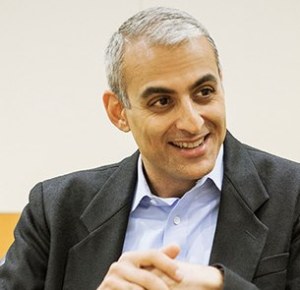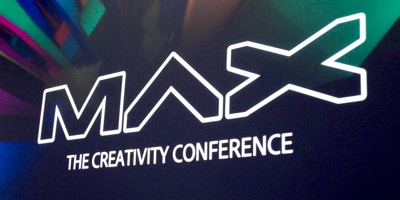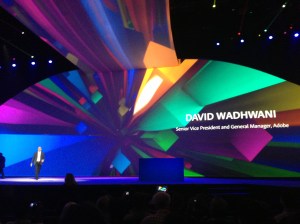Earlier today, I had a chance to sit down with Adobe’s David Wadhwani, the senior vice president and general manager for Digital Media and public face of Creative Cloud at the company’s MAX conference in Los Angeles this week. Adobe announced a number of product updates this week, but the most important and wide-reaching announcement was obviously the move to subscription services with Creative Cloud and the fact that the company will stop developing its Creative Suite. While there has been some pushback against this move, Wadhwani believes that most of the community is ready for this move and that it will help Adobe innovate faster and serve its users better.
Creative Cloud
As Wadhwani stressed when I talked to him, the company currently plans to sell Creative Suite 6 “indefinitely.” For him, it’s important to look at where the company sees the creative evolution going. Adobe, he believes, has to look at “where do we see the creative world going and the evolution that we think is going to take place.” Adobe’s strategy, he said.” To effect and lead some of these changes, he believes, Creative Cloud is the way to go for the company. What’s often missing in the creative workflows today, he said, “is that element of connectedness. Creativity today is too often done in isolation.” Connecting you to your co-workers and a larger community on, for example, Behance, “is a very empowering thing for a lot of creators.”
 If that’s where creation is going, he said, “it’s become very obvious for us that the best way for doing that is to create a truly integrated experience for creatives from their tools to all of these services and communities.” Adobe, he said, wants to put its resources into where the company can add the most value. In this context, the focus on creative cloud becomes a natural step in the company’s evolution.
If that’s where creation is going, he said, “it’s become very obvious for us that the best way for doing that is to create a truly integrated experience for creatives from their tools to all of these services and communities.” Adobe, he said, wants to put its resources into where the company can add the most value. In this context, the focus on creative cloud becomes a natural step in the company’s evolution.
The fact that the early reaction to Creative Cloud has been positive and that the company is seeing “good strong accelerating growth” has given Adobe the confidence “that as a whole, the creative community is open and obviously interested in moving in this direction.” He did, however, also acknowledge that not everybody will be ready to go this way and that it’s a big change that will take a bit to sink in. Adobe wants to have an open dialog with its users about this change and will also take its message on the road in the next few weeks. So far, he’s been very happy with the response from the creative community at MAX.
One aspect of Creative Cloud that Adobe hasn’t really talked about publicly is also that this change could prevent quite a bit of piracy. Making Photoshop and its other creative tools more affordable means that it’s now often easier for users to just pay a monthly subscription fee than to pirate the software. He also believes that all the extra services, including Behance, storage, syncing and many of the new tools the company has in store will get people to see that the value in subscribing to Creative Cloud goes beyond the tools.
The transition to Creative Cloud, to him, is not just about the business model, but also a cultural change. “The culture of Adobe has always been to appreciate the work that’s created by our customers,” he said. Going forward, Adobe wants to help amplify its users reach and it’s clear that Behance will play a central role in this. The tool wasn’t just showcased extensively during both MAX keynotes, but Wadhwani also talked about its role at great length during our conversation. To him, this is clearly an exciting and new aspect of what Adobe can do.
But What About Developers?
In return, however, the focus at MAX this week was clearly on designers and creatives and far less on developers than in previous years. That’s something Wadhwani also acknowledged in our chat. Going forward, Adobe isn’t taking its focus away from developers, “but refining where we focus in the stack.” Going forward, Adobe will put an emphasis on tools for user interface designers and user interface developers, especially as Adobe will continue to work with browser vendors. For enterprise developers and with regard to backend tools, he said, there are lots of other options out there and going forward, it seems, Adobe won’t devote all that many resources to them.
Adobe’s Hardware
 The other major announcement at MAX was obviously that Adobe is experimenting with hardware products. As much as I tried, though, I couldn’t get Wadhwani to say whether Adobe plans to turn these prototypes into actual products (my feeling, however, is that the company is definitely leaning in that direction). What Adobe wants to do with its hardware, he said, is to fill some of the gaps that it sees in the toolset right now. He’d be very happy, he said, if other hardware manufacturers made similar products or wanted to participate in the process, too, but in a way, it seems like Adobe is taking a similar approach as Google is with its Nexus devices by creating reference points for others. The tools the company showed today, he believes, will complete the profile that can turn touch devices like the iPad into full-blown tools for creative professionals.
The other major announcement at MAX was obviously that Adobe is experimenting with hardware products. As much as I tried, though, I couldn’t get Wadhwani to say whether Adobe plans to turn these prototypes into actual products (my feeling, however, is that the company is definitely leaning in that direction). What Adobe wants to do with its hardware, he said, is to fill some of the gaps that it sees in the toolset right now. He’d be very happy, he said, if other hardware manufacturers made similar products or wanted to participate in the process, too, but in a way, it seems like Adobe is taking a similar approach as Google is with its Nexus devices by creating reference points for others. The tools the company showed today, he believes, will complete the profile that can turn touch devices like the iPad into full-blown tools for creative professionals.
It also sounds as if Adobe is working on other hardware ideas, too, as Wadhwani described project Mighty, its stylus, as “the tip of the spear” of what Adobe is doing in terms of forward-leaning innovation. Tonight, at the MAX closing event, Adobe plans to show some sneak peeks at other projects in its labs, so it’ll be interesting to see if there will be more hardware announcements at that event, too.

